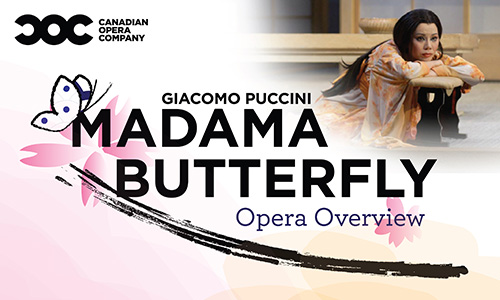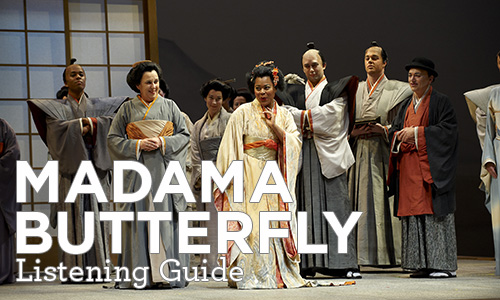-
Eight Things to Know: Giacomo Puccini’s Madama Butterfly
By Kiersten HayPosted in Madama ButterflyBy Nikita Gourski

1. IT’S A CLASSIC OPERAMadama Butterfly is the story of Cio-Cio San, a young Japanese geisha who seeks to fulfil her dreams through marriage to an American naval officer. Her faith in their future is shattered by his empty vows, and the loss she endures makes the opera’s tragic ending even more devastating. Butterfly is one of the most popular, most performed operas in the world.
[READ MORE] -
Madama Butterfly Journey: The Opera
By Kiersten HayPosted in Madama Butterfly
Madama Butterfly is one of Giacomo Puccini’s greatest works and one of the most popular operas in the world. The opera tells the tragic story of Cio-Cio San, a Geisha, who falls in love with B. F. Pinkerton, a U.S. naval officer, while he is stationed in Japan. Formed through layers of symbolism, musical history, and diverse cultures, the opera is filled with unique elements from the costumes to the arias that help make it a favourite of opera goers both old and new.
Explore our production of Madama Butterfly in our new series of infographics, where we guide you through the story and characters, costumes, makeup, and wigs, and the score, set, and artistic direction of our production. Get to know the show before you go, and catch a glimpse behind the scenes of Puccini’s perennial favourite.
[READ MORE] -
Madama Butterfly Listening Guide
By Kiersten HayPosted in Madama ButterflyBy Gianmarco Segato, Adult Programs Manager

Introduction
Puccini’s Madama Butterfly is generally considered one of the greatest works to emerge from the Italian verismo movement – that is, the short, concentrated period in operatic history which lasted from just 1892 (the premiere of Catalani’s La Wally) through 1926 (when Puccini’s Turandot marked its end). Verismo was the Italian response to the naturalist movement that originated in French literature, notably in the working-class milieus presented by Émile Zola and Guy de Maupassant. Italy found its equivalent in Giovanni Verga, author of the short story Cavalleria rusticana on which composer Pietro Mascagni based his 1890 verismo-defining opera of the same title.
Despite its origins in “realism” with stories based on contemporary, working-class life, the operatic iteration of the verismomovement soon shifted focus to explore more diverse subject matter which embraced the “exotic.” Consider this list of verismoheroines who emerged in the decades after 1892: noblewomen (Giordano’s Fedora; Cilea’s Gloria; and, the nobly born nun Angelica in Puccini’s Suor Angelica); courtesans (Stephana in Giordano’s Siberia; Puccini’s Magda in La rondine) and "oriental waifs" (Mascagni’s Iris and Puccini’s Liù in Turandot). So, it is an oversimplification to view verismo opera as dealing solely in subjects drawn from tawdry newspaper headlines (as did Verga’s and Mascagni’s Cavalleria rusticana). The proof is in Madama Butterfly, only the most famous example of how composers of this era, including Mascagni, strove to constantly expand and refine their art, searching for new and original subject matter to include such (then) “exotic” cultures like Japan’s.
[READ MORE]
